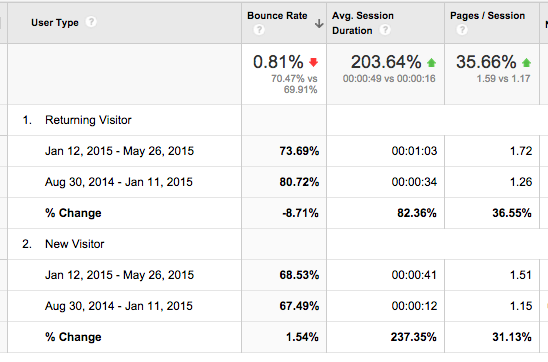For most PPC accounts, our focus is to gain revenue or leads. This gives us a (somewhat) clear idea of what kinds of optimizations to make and how we should run the account. However, for one account, the strategy shifted to boosting the quality of site visitors and user engagement. Using Google Analytics we came up with an action plan.
The Challenge
This particular client, who provides secure enterprise file sharing software, was having a hard time generating affordable leads through PPC. We were struggling to hit both conversion volume goals, as well as CPL goals.
The industry is very competitive, and CPCs are very high for non-branded search terms. For this reason, the account relied heavily on the use of the Display Network for leads. While these campaigns brought in leads, none were turning into revenue.
Opportunity
Looking at Google Analytics reports, we realized that the traffic we were driving with PPC wasn’t quality traffic. Sure, the volume was there, but the majority of users were bouncing off the site after very short session durations.
Our new goals were to generate new visitors to the site, with specific engagement metric goals for new and returning visitors.
Strategy
Targeting
Most of our lead generation previously was coming from Display Network campaigns. However, this traffic was largely unqualified. With high bounce rates, this meant we weren’t reaching the right audience (perhaps reaching individual consumers rather than businesses looking for an enterprise level solution).
With the shift in strategy, we paused all Display (besides remarketing) and instead launched a Custom Affinity Audiences campaign that used competitor domains to build the audience. For search campaigns, we stuck with mainly branded and competitor terms, as non-branded terms are too pricey for the client’s budget. Dynamic Search Ads are also running and do a pretty good job of bringing in relevant traffic based on the queries it’s picking up. For Display Remarketing, we are targeting users who visited specific pages of interest (pricing pages, etc) or spend a certain amount of time on the site.
Ad Copy
With new landing pages, our ad copy had to be changed to shift away from “free trial” messaging to “get more information” messaging. We made efforts to call out the unique features of the product, as well as language such as “explore” and “learn about our solutions.”
Landing Pages
This was a huge part of our strategy revamp. Before, we were using PPC only landing pages. As our focus was lead generation, these landing pages included a short bit of text explaining what the user was getting (either a free trial or a report download), and a form. The purpose of these pages was to keep the user on that page, free from distraction, so they would fill out the form with their name and email. Great for lead gen, but not so much for site engagement.
We swapped landing pages and began sending traffic to informational pages on the site. Places where users might stick around for a while to read more about the products and services the company offered.
New vs. Returning Visitors
To better gauge how performance differs between new and returning visitors, we split out all of our campaigns into new visitors and returning visitors. This was pretty simple to set up, I simply excluded All Visitors from our “New Visitor” campaigns, and set All Visitors to “target and bid” for our returning campaigns.
The next step in this process is to write different ad copy for these two segments of campaigns. New users will receive copy that’s more general, with a focus on broad benefits and features. Returning users will receive ads with more technical features, and language that this user may already be familiar with since they have already visited the site.
Results
As a result of the ad copy changes, along with targeting changes, we have seen great improvements in engagement metrics and CTR.



This type of focus for PPC isn’t for every client, but it may be something interesting for you to take a look at alongside your traditional PPC goals.



